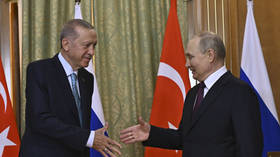Australian dollar strengthens on surging iron ore prices & greenback weakness
The Australian currency continued to gain on the US dollar on Monday, hitting AUD 1.32 against the greenback and reaching the highest level since 2018.
Over the year the Australian dollar has gained over seven percent against the greenback. The US dollar has lost nearly 6 percent this year against major global currencies, with the dollar index starting this week down 0.3 percent.
Also on rt.com Economic decoupling from China ‘act of national self-sabotage’ – Australian MPThe Australian dollar’s rally is believed to be driven by record prices for iron ore, as the country is one of world’s biggest suppliers of the metal. According to the World Steel Association, Australia accounted for nearly 60 percent of the global seaborne iron ore supply last year.
China is Australia’s key export market for the commodity. While trade tensions are mounting between Beijing and Canberra, the metal has not been hit by any tariffs so far.
Also on rt.com Australia vows to drag China to WTO over barley tariffs amid mounting trade tensions between the two nations“Elevated iron ore prices are … helping AUD to ignore bad news, including a further deterioration in Australia‑China government relations,” the Commonwealth Bank of Australia (CBA) said on Monday, as cited by CNBC. According to the bank, the fair value of the Australian dollar is largely based on commodity prices.
On Friday, supply concerns and strong steel demand drove iron ore futures to an all-time high. The price of iron ore then crossed the 1,000 yuan ($152.95) per ton mark for the first time in history. However, futures for the commodity retreated from historic levels on Monday, falling around four percent.
For more stories on economy & finance visit RT's business section














